Sound Class 9 Important Questions and Answers Science Chapter 12
VERY SHORT ANSWER QUESTIONS
Based on waves and sound
Question 1.
What is sound ?
Answer:
Sound is a form of energy which produces the sensation of hearing in our ears.
Question 2.
What does wave transfer ?
Answer:
Wave transfers energy.
Question 3.
What is a mechanical wave ?
Answer:
A waves that are characterised by the motion of particles of a medium are called mechanical waves. These waves require material medium for their propagation.
Question 4.
What is a transverse wave ? (CBSE 2011)
Answer:
If the particles of the medium vibrate about their mean positions at right angles to the direction of propagation of the disturbance, then the wave is called transverse wave. Light is a transverse wave.
Question 5.
Differentiate between crest and trough. (CBSE 2013)
Answer:
The highest point on the elevation of the medium through which transverse wave travels is called crest.
The lowest point on the depression of the medium through which transverse wave travels is called trough.
Question 6.
What is a longitudinal wave ? (CBSE 2011)
Answer:
If the particles of a medium vibrate or oscillate to and fro about their mean positions along the direction of propagation of the disturbance, then the wave is called longitudinal wave. Sound wave is a longitudinal wave.
Question 7.
Name a wave which does not require a material medium for its propagation. (CBSE 2012)
Answer:
Electromagnetic wave.
Question 8.
What do you understand by the terms “compression” and “rarefaction” ? (CBSE 2012)
Answer:
A region of high pressure of a medium when sound wave travels through it is called compression. A region of low pressure of a medium when sound wave travels through it is called rarefaction.
Question 9.
What happens to the medium through which sound travels ?
Answer:
A medium is divided into the regions of high pressure or high density and regions of low pressure or low density called compressions and rarefactions respectively.
Question 10.
Define time period. (CBSE 2011, 2013, 2017)
Answer:
Time Taken by two consecutive compressions or rarefactions to cross a fixed point is called time period.
Question 11.
State SI unit of time period.
Answer:
second(s)
Question 12.
What do you understand by the frequency of a sound wave ? (CBSE 2011)
Answer:
The number of compressions or rarefactions crossing a point in one second is called the frequency of a sound wave.
Question 13.
State SI unit of frequency compressions or rarefactions crossing a point, hertz (Hz).
Answer:
Question 14.
Write relation between time period (T) and frequency (v).
Answer:
Question 15.
What do you understand by the wavelength of a sound wave ? (CBSE 2015, 2017)
Answer:
Distance between two successive compressions or successive rarefactions is called wavelength of a sound wave.
Question 16.
State SI unit of wavelength. (CBSE 2012)
Answer:
metre (m).
Question 17.
State the meaning of the term “amplitude with reference to a wave. Mention its SI unit. (CBSE 2013)
Answer:
Maximum displacement of a particle of the medium from its mean position when wave travels through the medium. It SI unit is metre.
Question 18.
What type of wave is represented by density-distance graph ? (CBSE 2011)
Answer:
Longitudinal wave.
Question 19.
Name the physical quantity whose unit is ‘hertz’. (CBSE 2015)
Answer:
Frequency.
Question 20.
What do you understand by the pitch of a sound ? (CBSE 2012)
Answer:
Pitch of a sound is the characteristic of sound that depends on the frequency received by a human ear.
Question 21.
Name the physical quantity which determines the pitch of a sound.
Answer:
Frequency of a sound wave.
Question 22.
Write factor on which pitch of a sound depends ? (CBSE 2011, 2012)
Answer:
Pitch of a sound depends on the frequency of the wave.
Question 23.
What do you understand by the loudness of a sound ? (CBSE 2012)
Answer:
Amplitude of the vibrating body determines the loudness of the sound. Large is the amplitude of vibration, large is the loudness of the sound produced.
Question 24.
What do you mean by the intensity of sound ? (CBSE 2011)
Answer:
Sound energy per unit time per unit area is known as the intensity of sound.
Question 25.
Write the S.I. unit of intensity of sound.
Answer:
Js-1 m2 or Wm-2.
Question 26.
Out of which of the following media, the speed of sound is maximum : solid, liquid, gas.
Answer:
The speed of sound is maximum in solid medium.
Question 27.
Draw diagram to represent sound of high pitch and (b) low pitch, of the same loudness. (CBSE 2011, 2012)
Answer:
Question 28.
Name the physical quantity which determines the loudness of a sound.
Answer:
Amplitude of the vibrating body.
Question 29.
Define the characteristic “timbre” or “quality” of a sound. (CBSE 2012, 2015)
Answer:
Quality or timbre is a characteristic of a sound which enables us to distinguish between two sounds of some loudness and pitch.
Question 30.
Speed of sound is more on hotter day. Explain. Why ? (CBSE 2013)
Answer:
Speed of sound increases with increase in temperature.
Based on Reflection of sound
Question 31.
What is an echo ? (CBSE Sample Paper 2010, 2011, 2012, 2015)
Answer:
Echo is a repetition of sound due to the reflection of original sound by a large and hard obstacle.
Question 32.
What should be the minimum distance between the source of sound and the obstacle to hear an echo ?
(CBSE 2011)
Answer:
17 metres.
Question 33.
Give one application where principle of echo is utilised. (CBSE 2011)
Answer:
Hearing aid.
Question 34.
Give example of multiple echoes. (CBSE 2014)
Answer:
- Rolling of thunder,
- Whispering galleries.
Question 35.
What do you understand by the reverberation ? (CBSE 2011, 2012, 2013)
Answer:
The penomenon of prolongation of original sound due to the multiple reflection of sound waves even after the source of sound stops producing sound is called reberberation.
Question 36.
What is reverberation time ?
Answer:
The time interval during which original sound appears to prolong.
Question 37.
What are infrasonic waves ? (CBSE 2012, 2013)
Answer:
The waves of frequency less than 20 Hz are called infrasonic waves.
Question 38.
What are ultrasonic waves ? (CBSE 2012, 2013)
Or
What is ultrasound ? (CBSE 2012, 2015, 2017)
Answer:
The waves of frequency greater than 20,000 Hz are called ultrasonic waves or ultra sound.
Question 39.
What type of waves are produced by bats ?
Answer:
Ultrasonic waves.
Question 40.
State one important use of ultra sounds in industries.
Answer:
Ultra sounds are used to find faults and cracks in metals.
Question 41.
State two important uses of ultrasounds for medical purpose. (CBSE 2011, 2012, 2013, 2014)
Answer:
- Diagnosing the diseases in human body
- To analyse the development of an unborn child.
Question 42.
If 20 waves are produced per second, what is the frequency in Hertz ? {CBSE 2011)
Answer:
Frequency = 20 Hz.
Question 43.
What is echocardiography ? {CBSE 2012)
Answer:
It is the technique to construct the image of heart using ultrasonic waves.
Question 44.
Echoes can’t be heard in a small room. Explain. (CBSE 2013)
Answer:
The minimum distance between source of sound and the obstacle! to hear an echo should be 17m.
Question 45.
Therefore, echoes can’t be heard in a small room.
Or
Write the hill form of “SONAR”. (CBSE 2011, 2015)
Or
What is the acronym of SONAR ? (CBSE 2012)
Answer:
SONAR stands for Sound Navigation And Ranging.
Question 46.
What is the basic principle on which SONAR works ? (CBSE 2011, 2016)
Answer:
SONAR works on the principle of reflection of waves (i.e. echo).
Question 47.
Write one application of SONAR. (CBSE 2011, 2012)
Answer:
It is used to measure the depth of a sea.
Question 48.
What is the function of a detector in a SONAR ? (CBSE 2011)
Answer:
It detects the echo received to find the time taken by the wave to reach the SONAR from the bed of sea.
SHORT ANSWER QUESTIONS
Based on waves and sound
Question 1.
Mention the types of mechanical waves. Identify the type which can be produced in solids, liquids and gases. (CBSE 2015)
Answer:
Types of mechanical waves :
- Transverse wave,
- Longitudinal wave
Longitudinal wave can be produced in solids, liquids and gases.
Question 2.
Describe an activity to show that sound waves need medium to travel. (CBSE 2011, 2012)
Answer:
Sound Needs a Medium to Travel:
We have learnt that sound travels from one place to another place when the energy is transferred from one particle to another particle of a medium like air or gas, liquid, solid etc. It means, sound needs a material medium for its propagation. In other words, sound cannot travel through vacuum.
Demonstration to show that sound waves cannot travel through vacuum:
Put an electric bell inside a closed glass jar connected with a vacuum pump. Initially, air from the jar is not taken out. Connect the electric bell with a battery (Figure 10). It rings and the sound produced is heard by us.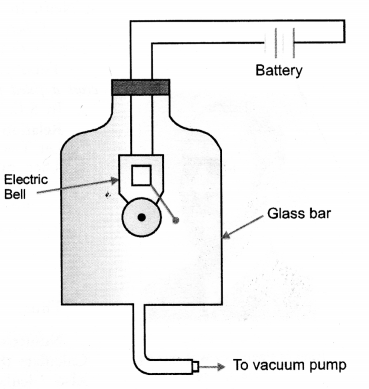
Now start evacuating the air from a glass jar using a vacuum pump, we will hear less and less sound, i.e. the loudness of the sound decreases. When there is no air in the glass jar, we do not hear sound. This activity demonstrates that sound waves require material medium (in this case air) for its propagation.
Question 3.
Sound cannot travel through vacuum. How will you demonstrate this fact ?
Answer:
Demonstration to show that sound waves cannot travel through vacuum:
Put an electric bell inside a closed glass jar connected with a vacuum pump. Initially, air from the jar is not taken out. Connect the electric bell with a battery (Figure 10). It rings and the sound produced is heard by us.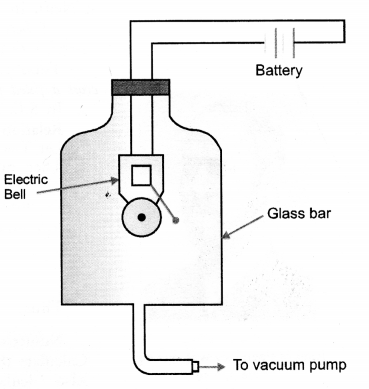
Now start evacuating the air from a glass jar using a vacuum pump, we will hear less and less sound, i.e. the loudness of the sound decreases. When there is no air in the glass jar, we do not hear sound. This activity demonstrates that sound waves require material medium (in this case air) for its propagation.
Question 4.
Write any three differences between transverse and longitudinal waves. (CBSE 2012, 2013)
Answer:
| Transverse Wave | Longitudinal Wave |
| 1. In transverse wave propagation, the particles of the medium vibrate about their mean or equilibrium position at right angles to the direction of the propagation of the wave. | In longitudinal wave, particles of the medium vibrate about their equilibrium position along the direction of the propagation of the wave. |
| 2. When transverse wave travels through a medium, the shape of the medium changes. | When longitudinal wave travels through a medium, medium is divided into the regions of high and low pressures. |
| 3. Traverse wave can travel in solids and on the surface of liquids. | Longitudinal waves can travel in solids, liquids and gases. |
Question 5.
Show that v = λv, where symbols have usual meanings.
Or
Establish relationship between speed of sound, its wavelength and frequency.
(NCERT Question Bank,CBSE 2012)
Answer:
Let the time period of a vibrating body be T. It means, the vibrating body completes one oscillation in time T. One oscillation of a body is represented by a wave of wavelength λ as shown in figure 15.

Thus, speed of wave= wavelength x frequency
Note : The speed of a mechanical wave (i.e. sound wave) is constant in a given medium. If sound of large frequency is produced by a vibrating body, then the wavelength of this sound wave will be small, so that speed = wavelength x frequency is constant
The speed of a sound wave differs only when the sound wave goes from one medium to another medium.
Question 6.
Sounds of same loudness and pitch but produced by different musical instruments like a violin and flute are distinguishable. Explain, why ? (CBSE 2012)
Or
In an orchestra, violin and flute are played at the same time but still these are distinctly recognizable. Name the characteristic that makes it possible. (CBSE 2012)
Or
Name the characteristic of sound that helps us to distinguish a note played on a sitar and a violin.
(CBSE 2012)
Answer:
This is due to the quality or timbre of sound waves.
Question 7.
A vibrating body produces sound. However, no sound is heard when a simple pendulum oscillates in air.
Explain the reason. (NCERT Question Bank)
Answer:
Sound is heard only if the body vibrates with a frequency more than 20 Hz and less than 20,000 Hz. The pendulum oscillates or vibrates with a frequency less than 20 Hz. Hence, no sound is heard when the pendulum vibrates or oscillates in air.
Question 8.
A boy strikes one end of a long iron pipe with a stone. Another boy who keeps his ear close to the other end of the pipe heard two sounds in a short interval of time. Explain, why? (CBSE 2011)
Answer:
When a boy strikes an iron pipe, sound is produced. The sound waves travel through air and the pipe. Since speed of sound in iron is greater than the speed of sound in air, so the sound travels faster through iron pipe than air. Hence, another boy hears two sounds, one travelling through iron pipe and the other travelling through the air.
Question 9.
Sound travels faster in summer season than in winter season. Explain, why ?
Answer:
This is because, speed of sound increases with increase in temperature.
Question 10.
Why is the speed of sound greater in solids than in gases ?
Answer:
This is because particle of solids are closer than the particles of gases.
Question 11.
Draw a graph for a wave representing wave distrubance and time for a sound changing from low pitch to
high pitch, keeping amplitude of the sound same. (CBSE Sample Paper; 2011)
Answer:
Question 12.
Waves of frequency 100 Hz are produced in a string as shown in figure. Give its :
(a) amplitude,
(b) wavelength
(c) velocity
(CBSE 2011, Similar CBSE 2014, 2015)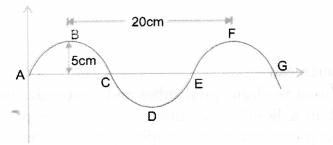
Answer:
Here, v = 100 Hz
(a) Amplitude = 5 cm
(b) Wavelength = distance between two successive crests or troughs = 20 cm.
(c) Velocity, u = vλ = 100 Hz x 0.2 m = 20 m s-1
Question 13.
State the factors on which speed of sound depends. (CBSE 2011, 2012)
Answer:
Speed of sound depends on :
- nature of medium and
- temperature of the medium.
Speed of sound in solids is greater than in liquids and speed of sound in liquids in greater than in gases. Speed of sound increases with the increase in temperature of the medium and it decreases with the decrease in temperature of the medium.
Question 14.
The sound of an explosion on the surface of a lake is heard by a boatman 100m away and a diver 100m
below the point of explosion. Of the two presons mentioned (boatman or diver) who would hear the sound first ? And why ? {CBSE 2011, 2015)
Answer:
Since velocity of sound in water is more than the velocity of the sound in air, so the diver in the water will hear the sound of explosion earlier than the boatman.
Based on Reflection of sound
Question 15.
State two conditions for echo to be heard. (CBSE Sample Paper 2010, 2011, 2012, 2015)
Answer:
Echo can be heard if
- the minimum distance between the source of sound and the obstacle is 17 m.
- the obstacle is rigid and hard.
Question 16.
The reverberation time of a hall used for speeches should be very short. Explain why?
Answer:
If the reverberation time of a hall is long, then the multiple echoes will interfere with the original sound. Hence nothing will be heard distinctly. For this reason, the reverberation time of the hall should be very short.
Question 17.
Explain, how can you demonstrate the reflection of sound.
Answer:
When a sound wave travelling in a medium bounces back to the same medium after striking the second medium (which is solid), reflection of sound wave is said to take place. The reflection of sound wave is similar to the bouncing back of a rubber ball after striking a wall or the surface of a floor.
Just like light, sound is reflected by the solid and liquid surfaces. The reflection of sound obeys the laws of reflection. The laws of reflection of sound are as follows :
- Incident angle = Reflected angle and
- The incident direction of sound, reflected direction of sound and the normal to the point of incidence all lie in the same plane.
Question 18.
Describe multiple echoes. Write any two of their important applications. (CBSE 2011)
Answer:
When a sound wave is reflected many times by an obstacle, multiple echoes are heard. Multiple echoes are heard in whispering galleries.
Question 19.
State the laws of reflection of sound. (CBSE 2011)
Answer:
- Incident angle = reflected angle of sound wave
- Incident direction of sound, reflected direction of sound and the normal to the point of incidence all lie in the same plane.
Question 20.
Why we cannot hear an echo in a small room ? (CBSE 2011, 2012)
Answer:
To hear an echo, the minimum distance between the source of sound and the obstacle reflecting sound
waves must be 17m. However, the size of the room (i.e. the distance between two opposite walls) is less than 17m. Hence, we cannot hear an echo in a small room.
Question 21.
Mention one advantage and one disadvantage of reverberation. (CBSE 2013)
Answer:
A certain amount of reverberation improves the quality of sound of orchestral and choral music. However,
excessive reverberation makes the speech or music indistinct.
Question 22.
Draw a diagram showing laws of reflection followed by sound waves and label the following :
Incident wave, Reflected wave, Angle of incidence and Angle of reflection. (CBSE 2013)
Answer: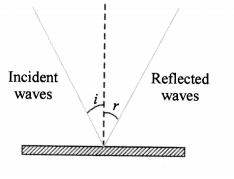
Based on ultra sound, sonar and human ear
Question 23.
Explain how ultra sound is used to clean spiral tubes and electronic components ? (CBSE 2011, 2014)
Answer:
The spiral tubes are dipped in a liquid. The ultrasonic waves are passed through this liquid. These waves force the dirt or any other impurity out from the spiral tube and hence the tube is cleaned.
Question 24.
Waves of special frequencies are used for cleaning hard to reach places.
(a) Name the waves
(b) What is the frequency of these waves ?
(c) Explain how do these waves perform this work. (CBSE 2015)
Answer:
(a) Ultrasonic waves
(b) Frequency of ultrasonic waves is greater than 20,000 Hz and less than or equal to 107 HZ.
(c) The spiral tubes are dipped in a liquid. The ultrasonic waves are passed through this liquid. These waves force the dirt or any other impurity out from the spiral tube and hence the tube is cleaned.
Question 25.
Give three medical uses of ultrasound. (CBSE 2014)
Answer:
- Diagnosing diseases in human body,
- To study the development of an unborn baby
- In echocardiography.
Question 26.
Why do we hear sound produced by the humming bees while the sound of vibrations of pendulum is not heard ? (CBSE 2011, 2013, 2015, 2016)
Answer:
Humming bees produces waves of frequency greater than 20 Hz, which are audible to us. On the other hand, frequency of vibration of pendulum is less than 20 Hz, which is not audible to us.
Question 27.
List three points which an engineer should use while designing an auditorium. (CBSE 2013)
Answer:
- Reverberation time should be small (or short).
- The ceiling of the auditorium should be curved.
- The ceiling of the auditorium should be made up of sound absorbing material.
Question 28.
A man fires a rifle in front of a cliff and hears the echo after 3 seconds. Calculate the distant of man from the cliff if velocity of sound in air is 340 m/s. (CBSE 2013)
Answer:
Time taken by sound to travel a distance between man and cliff, t = 3/2 = 1.5 s.
∴ Distance of man from the cliff, S = vt = 340 x 1.5 = 510 m.
Question 29.
A detector installed on a ship receives an ultrasonic signal sent to underwater object after v seconds of its transmission. If the speed of sound in water is ‘v’ what is the depth of object. (CBSE 2015)
Answer:
Time taken by the signal to reach detector from the depth of object = t/2.
Speed of signal in water = v
∴ Depth of the object = vt/2.
Question 30.
What is ultra sound ? Explain how defects in a metal block can be detected using ultra sound.
(CBSE 2011, 2012)
Answer:
The waves of frequency range greater than 20,000 Hz and equal to 107 Hz are known as ultrasound.
A beam of ultrasound is thrown on the metal block under investigation. The picture of the metal block produced by the reflected ultrasound is taken on the screen or the monitor of the computer. The position of the crack or fault in the metal block can be detected by analysing the picture.
Question 31.
How is the pressure variation in a sound wave amplified in human ear ? (CBSE 2011)
Or
How does the ear drum of human ear vibrate ? (CBSE 2012)
Answer:
The sound wave in the form of high pressure (compressions) and low pressure (rarefactions) reach the ear drum. When sound waves fall on ear drum, it begins to vibrate. The vibrations produced by the ear drum are amplifed by the three ossicles (i.e. hammer, anvil and the stirrup) in the middle of the ear.
LONG ANSWER QUESTIONS
Question 1.
Describe with the help of a diagram, how compressions and rarefactions are produced in air near a source of sound.
Answer:
When a body vibrates, then the particles of the medium (say air) around the vibrating body are set into vibrations. The particles of the medium which are very close to the vibrating body are pushed away from the body. These particles of the medium strike against the neighbouring particles. Hence the number of particles of the medium in the region where the displaced particles strike against the neighbouring particles is large. This region is known as compression (C).
Since pressure is directly proportional to the number of particles, so the compression is a region of high pressure or high density. When the vibrating body moves backward, a region of emptiness known as rarefaction (R) or a region of low pressure or low density is created. The displaced particles of the medium rebound into the region of low pressure or rarefaction. At the same time, compression is followed outwards.
Therefore, when a body vibrates to produce sound, compressions and rarefactions follow one another as the sound travel through the medium away from the vibrating body. Thus, propagation of sound can be visualised as the propagation of pressure variations or density variations in the medium.
Figure 9 represents the regions of compressions (or high pressures) and rarefactions (or low pressures) as the sound propagates in the medium.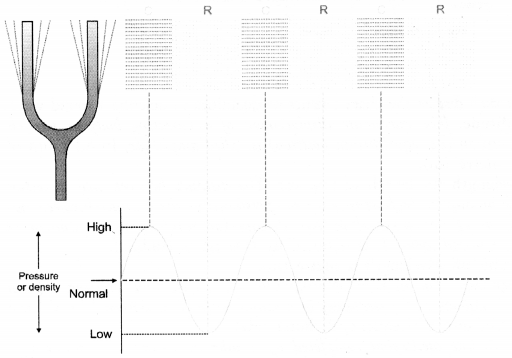
Question 2.
What is reflection of sound ? State laws of reflection of sound.
Answer:
When a sound wave travelling in a medium bounces back to the same medium after striking the second medium (which is solid), reflection of sound wave is said to take place. The reflection of sound wave is similar to the bouncing back of a rubber ball after striking a wall or the surface of a floor.
Just like light, sound is reflected by the solid and liquid surfaces. The reflection of sound obeys the laws of reflection. The laws of reflection of sound are as follows :
- Incident angle = Reflected angle and
- The incident direction of sound, reflected direction of sound and the normal to the point of incidence all lie in the same plane.
Question 3.
Give five practical applications of reflection of sound.
Answer:
- Megaphone is a device used to address public meetings. It is a horn-shaped. When we speak through megaphone, sound waves .are reflected by the megaphone. These reflected sound waves are directed towards the people (or audience) without much spreading (Figure 20).
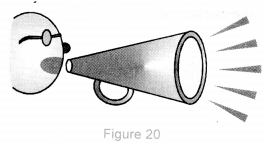
- Hearing Aid: Hearing aid is used by a person who is hard of hearing. It is an electronic device which is designed to amplify sound for the wearer to make the speech understandable. The microphone of hearing aid converts sound into electrical signals. These signals are amplified by the amplifier and then fed to the speaker. The speaker converts electrical signal to sound and then feed it into the ear as a narrow beam of sound waves. This narrow beam of sound waves fall on the diaphragm of the ear. Hence, the diaphragm of the ear vibrates with large amplitude. Therefore, the hearing power of the person is improved.
- Sound waves from the speaker are reflected by the sound board and these reflected waves are directed towards the people (or audience).
Sound boards. Sound boards are curved surfaces (concave) which are used in a big hall to direct the sound waves towards the people sitting in a hall. The speaker is (i.e. source of sound) placed at the focus of the sound board as shown in figure 21.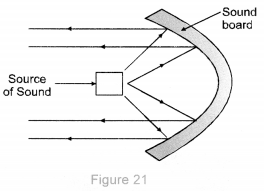
- Stethoscope: Stethoscope is a device used by doctors to listen the sound produced by heart and lungs. The sound produced by heart beat and lungs of a patient reaches the ears of a doctor due to multiple reflection of sound (Figure 22).
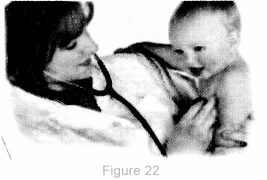
- Ceilings of concert halls are curved. The ceilings of concert halls and auditoriums are made curved. This is done so that the sound reaches all the parts of the hall after reflecting from the ceiling of the hall as shown in figure 23.
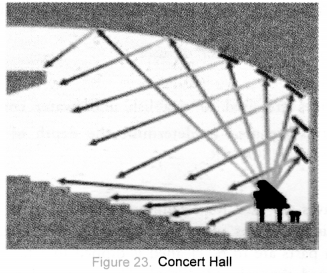
Moreover, these ceilings are made up of sound absorbing materials to reduce the reverberation.
Question 4.
Give five practical applications of ultrasonic waves. (CBSE 2011)
Or
Explain the technique of ultrasonography. (CBSE 2016)
Answer:
Ultrasonic waves have number of uses :
- For Communication
- Ultrasonic waves are used to establish underwater communication.
- Ultrasonic waves are used to determine the depth of a sea. It is done with the help of a SONAR.
- Industrial uses
- Ultrasonic waves are used for cleaning the hidden parts of an instrument. The process is known as ultrasonic cleaning. The instrument or device whose hidden parts are to be cleaned is dipped in a liquid. The ultrasonic waves are passed through this liquid. These waves forces the dirt or any other impurity out from the parts of the instrument which otherwise cannot be approached directly.
- Ultrasonic waves are used for welding plastic. Two plastic surfaces are pressed against each other. Then ultrasonic waves are allowed to fall at a point where plastic surfaces are in contact. These waves produces heat energy. This heat energy binds the two plastic surfaces together.
- Ultrasonic waves are used to find faults and cracks in metals. Ultrasonic waves are thrown on a metal under investigation. The beam of ultrasonic waves reflected by the metal is investigated. The intensity of the ultrasonic waves reflected from the fault or a crack is different from the intensity of the waves reflected from the other part of metal. Thus, the position of the fault or a crack in the metal can be easily located. In fact, the picture of the metal produced by the reflection of ultrasonic waves is taken on the screen or the monitor. By analysing this picture, the position and size of the crack or fault in the metal is detected.
- Medical uses
- Ultrasonic waves are used for diagnosing the diseases in human body. Different parts of the body like bone, fat, muscles and liquid have different reflective properties. Ultrasonic waves are allowed to fall on the portion of the body of a patient to be diagnosed. These waves are reflected back by the different parts (like bones, tissues, liquids and muscles etc.) of that portion of the body in different manners. The varying echoes are recorded for analysing that part of the body.
The method used for diagnosing the different part of a human body with the help of the ultrasonic waves is known as ultrasonography. - Ultrasonic waves are used to kill bacteria in liquids. Thus, the liquids like milk can be preserved for a longer period of time.
- Ultrasonic waves are also used to study the development of an unborn child. Any abnormality in the growth of an unborn child can be detected by the observing the picture taken by ultrasound.
- Echocardiography. It is medical diagnostic technique in which ultrasonic waves are used to construct the image of heart.
- Ultrasonic waves are used for diagnosing the diseases in human body. Different parts of the body like bone, fat, muscles and liquid have different reflective properties. Ultrasonic waves are allowed to fall on the portion of the body of a patient to be diagnosed. These waves are reflected back by the different parts (like bones, tissues, liquids and muscles etc.) of that portion of the body in different manners. The varying echoes are recorded for analysing that part of the body.
Question 5.
Write the full name of SONAR. How will you determine the depth of a sea using echo ranging ?
(CBSE 2011, 2012)
Or
Explain the working of SONAR. (CBSE 2014)
Answer:
SONAR stands for Sound Navigation and Ranging.
It is a device which is used in the ships to locate rocks, icebergs, submarines, old ships sank in sea etc. It is also used to measure the depth of a sea.
Principle: It is based on the principle of the reflection of sound wave (i.e. echo).
Determination of the Depth of a Sea using Sonar
A beam of ultrasonic waves from the transmitter of a SONAR fitted on the ship is sent towards the bottom of the sea (Figure 25).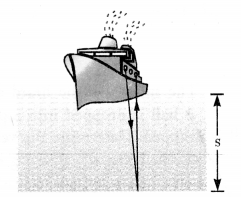
This beam is reflected back from the bottom of the sea and is received by the receiver or detector of the SONAR on the ship.
The time taken by the ultrasonic waves to go from the ship to the bottom of the sea and then back to the ship is noted. Let it be V seconds. Therefore, the time taken by the ultrasonic waves to go from the ship to the bottom of
The method of finding the distance of object using echo is called echoranging. While, the method of finding the depth of the sea using echo is called echo-depth ranging. In this case, SONAR is called fathometer.
Question 6.
Explain by drawing a diagram, how the human ear works.
Or
Explain how human ear works in the transmission of sound waves to the brain. (CBSE 2011, 2013)
Or
Draw labelled diagram of auditory part of human ear and explain how the human ear works. (CBSE 2012)
Answer:
The human ear is divided into three parts— the external ear, the middle ear and the inner ear (Figure 26).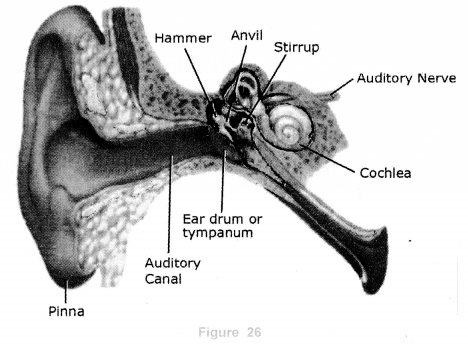
We shall discuss only the auditory aspect of the ear and not its detailed structure.
The external ear which we see is known as Pinna. This part collects the sound and sends it to the auditory canal.
The sound in the form of compressions (high pressure) and rarefaction (low pressure) reaches the ear drum or tympanum. When the compressions and rarefactions strike the ear drum, the ear drum begins to vibrate. These vibrations are transmitted across the middle ear by the three ossicles (the hammer, the anvil and the stirrup). The vibrations produced by the eardrum are amplified (i.e., their amplitude is increased) by the hammer, anvil and the stirrup.
The amplified vibrations are then transmitted to the cochlea. Cochlea is a coiled and fluid filled tube having the sense organ of hearing. The movement of the fluid in the cochlea due to the vibrations stimulates the auditory nerve. The impression (in the form of electrical signals) is carried by the auditory nerve to the brain. This impression is interpreted as sound by the brain.
Question 7.
Explain the technique of ultrasonography.
Answer:
Ultrasonics or Ultrasound
The waves of frequency greater than 20,000 Hz are known as ultrosonic waves or ultrasound. The frequency of ultrasonic wave is greater than 20,000 Hz and equal to 107 Hz. These waves are not audible to a human ear but they can be heard by animals and birds.
Bats can produce ultrasonic waves by flapping their wings. They can also detect these waves. The ultrasonic waves produced by the bats after reflection from the obstacles like buildings guide them to remain away from the obstacles during their flights. Hence, they can fly during night without hitting the obstacles. Bats also catch their prey during night with the help of ultrasonic waves. The ultrasonic waves produced by a bat spread out. These waves after reflecting from a prey say an insect reach the bat. Hence, the bat can easily locate its prey (Figure 24).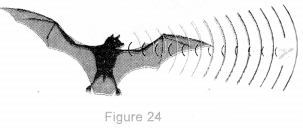
Dolphins also produce ultrasonic waves. Dolphins can also detect the ultrasonic waves. They catch their prey like a fish due to their ability to detect the ultrasonic waves reaching them after reflecting’ from a fish.










